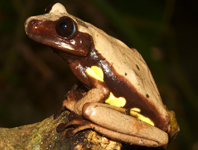Abstract
Fungus-feeding is common amongst members of the family Phlaeothripidae that live on dead branches and leaves (Dang et al. 2014). In contrast, associations with fungi are rare amongst the common thrips of the family Thripidae that live in flowers and on leaves. In this family, two species from Africa in the genus Craspedothrips are reported to be associated with the rust fungus, Hemileia vastatrix, on the leaves of coffee plants (Mound et al. 2012), although there are no reports of direct feeding by the thrips on the fungus. However, the two known species of the Asian genus Euphysothrips have been observed to feed on the spores of rust fungi at widely separated localities. One of these, fungivora, was described by Ramakrishna (1928) in the genus Anaphothrips, and he reported this thrips as feeding on “rust” on wheat plants at Coimbatore, India. Ananthakrishnan (1969: 5) subsequently referred to this species as “feeding on the spores of wheat rust, Puccinia graminis”. The second species of Euphysothrips was described by Ramakrishna and Margabandhu (1939) as a new genus and species, Megaphysothrips subramanii, from Mysore in southern India. These authors stated that this thrips was found feeding on coffee rust, and a similar feeding association on coffee was reported from Timor in 1967, when specimens of subramanii were submitted for identification to the Natural History Museum, London. In Timor Leste during August 2018, adults and larvae of subramanii were found commonly on the leaves of coffee plants. The thrips were living only on the reddish-pink patches of Hemileia vastatrix fungus (Fig. 6), and not freely exploring the rest of the leaf surface. Both adults and larvae were difficult to see on these patches of fungus, because each individual was noted to carry a covering of coloured spores. This pinkish covering was shed only when an individual was disturbed by attempts to collect them with a small brush. There was no evidence of feeding damage to the coffee leaves by the thrips, and it appears that subramanii is probably dependent on the rust fungus for its nourishment.
References
Ananthakrishnan, T.N. (1969) Indian Thysanoptera. CSIR Zoological Monograph, 1, 1–171.
Ananthakrishnan, T.N. & Sen, S. (1980) Taxonomy of Indian Thysanoptera. Zoological Survey of India, Handbook Series, 1, 1–234.
Bagnall, R.S. (1926) Contributions towards a knowledge of the European Thysanoptera. I. Annals and Magazine of Natural History, Series 9, 18, 641–661.
https://doi.org/10.1080/00222932608633561
Bhatti, J.S. (1972) A study of variation in Euphysothrips minozzii Bagnall. Entomologist's Monthly Magazine, 107, 149–152.
Dang, L.-H., Mound, L.A. & Qiao, G.-X. (2014) Conspectus of the Phlaeothripinae genera from China and Southeast Asia (Thysanoptera, Phlaeothripidae). Zootaxa, 3807 (1), 1–82.
http://dx.doi.org/10.11646/zootaxa.3807.1.1Mound, L.A. (1968) A review of R.S. Bagnall's Thysanoptera collections. Bulletin of the British Museum (Natural History), Entomology Supplement, 11, 1–181.
Mound, L.A., Masumoto, M. & Okajima, S. (2012) The Palaeotropical genus Craspedothrips, with new species from Africa and Malaysia (Thysanoptera, Thripinae). Zootaxa, 3478, 49–61.
Priesner, H. (1965) A monograph of the Thysanoptera of the Egyptian deserts. Publications de l’Institut Desert d’Egypte, 13, 1–549.
Ramakrishna, A. (1928) A contribution to our knowledge of the Thysanoptera of India. Memoirs of the Department of Agriculture of India, Entomology Series 10, 7, 217–316.
Ramakrishna, A. & Margabandhu, V. (1939) Notes on new and known Indian Thysanoptera. Records of the Indian Museum, 41, 21–33.
Tyagi, K. & Kumar, V. (2016) Thrips (Insecta: Thysanoptera) of India - An Updated Checklist. Halteres, 7, 64–98.
zur Strassen, R. (2003) Die terebranten Thysanopteren Europas und des Mittelmeer-Gebietes. Die Tierwelt Deutschlands, 74, 1–271.

